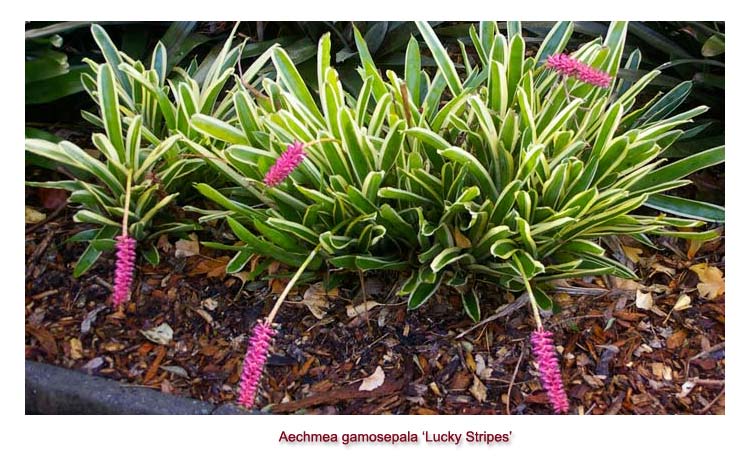Aechmea (eck-mee-uh)
Aechmea are Bromeliads from Central and South America with over over 250 species in general cultivation, varying in height from around 40cms up to 2m.
But it's the very attractive cultivars that gain most attention with their dramatic foliage and colourful flower heads, with over 500 now available from your local nursery or garden centre.
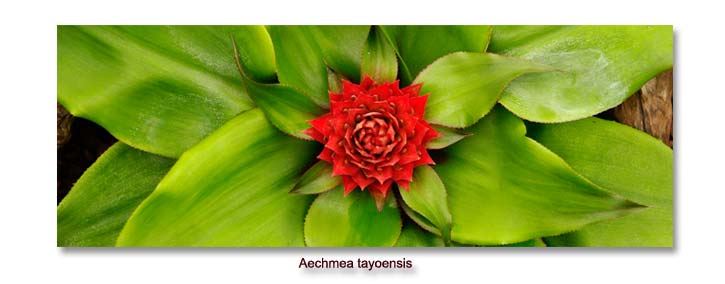
Epiphytes:
Aechmea are mainly epiphytes e.g. they get their moisture and nutrients from the air and a central well or vase that collects water. They do have roots but these are generally for anchoring the plant which can be on the ground, on rocks or perched in crevices on other plants like trees.
 Foliage:
Foliage:
Aechmea are renowned for their striking foliage that is strap-like and arches outwards from a central rosette. Many have coloured or patterned leaves featuring stripes or bars or random speckles of contrasting shades.
The name Aechmea comes from the Greek ‘aichne’ meaning ‘spear-tip’ referring to both the flower head and the leaf shape and some plants also feature foliage with prickly margins like Aechmea agavifolia or Aechmea pineliana.
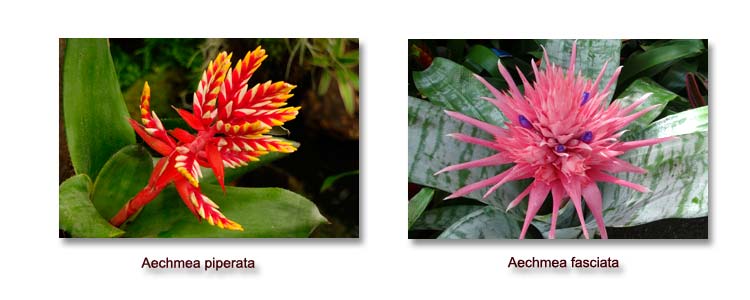
Flowers:
Some Aechmea produce the most striking flowers you’ll ever see, while others can be a bit ‘ordinaire’. All flowers are held aloft on spear-like stalks and often feature brilliantly coloured bracts beneath the actual flowers. The flowers are strong attractants for hummingbirds and other pollinators and tend to last for long periods.
Aechmea fasciata is perhaps the most famous with its amazing pink conical flower-head, Aechmea piperata demands attention with its vibrant red and yellow colouring while Aechmea ‘Blue Rain’ features the ‘scattered-spray’ flower form which in its own case is astonishingly attractive.
Aechmea are however ‘monocarpic’ in that they only ever produce one flower before dying off. But they do produce ‘pups’ or off-sets’ after flowering which can be separated and re-potted or just left to feed of the mother plant as it slowly decays and dies.
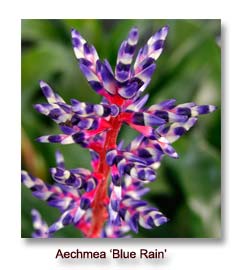 Growing Aechmea:
Growing Aechmea:
They can be planted directly into garden soil as long as it is very well drained.
Light, sandy or rocky soils are perfectly good for Aechmea, as is loose bark mulch. The most important thing is to ensure they are well anchored and a few large pebbles or rocks are good to weigh down the rather small root ball.
They can also of course be anchored in a tree or shrub crevice which is one of their most common perches in nature.
If you plan to grow them largely indoors then you won’t need a large pot as the rootball is never as large as the foliage spray. You will need it to be heavy enough though to stay upright.
Use a well draining potting mix as per Orchids and other Bromeliads and never let the roots stay wet for prolonged periods as they will rot very quickly and kill the plant.
Lighting:
Keep them well lit but clear of direct sunlight which will scorch the leaves in excess. Dappled light under trees is best or indirect light near a window if kept indoors. A little direct sunlight is OK, especially the milder early morning sun, but avoid the scorching afternoon sun if possible.
Temperatures:
Its best to keep them warm though they will handle cooler nights down to around 10C quite well and cooler still if in a sheltered location, but if its getting lower than around 6-7C then they are best brought indoors. In summer they can handle quite high temperatures providing its humid and shaded - coming as they do from Central and Southern America.
Watering:
They store their own water in the central vase or well but its worth flushing this out every week or so to keep it fresh and free of bacteria and other contaminants. They do like it humid though, so a regular misting by hand for indoor plants or a simple spray of the foliage with a hose for those kept outdoors will always be appreciated.
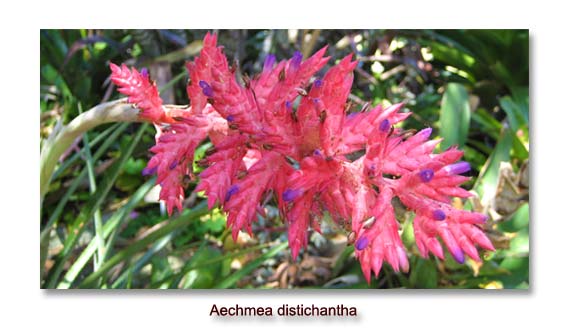
Fertilisation:
Apply a balanced, slow release fertiliser a couple of times through spring and summer or spray a diluted formulation onto the leaves once a month.
If you want to encourage new blooms then fertilise with some Epsom Salts (magnesium sulphate) - the magnesium is a critical element for the production of chlorophyll and flowers. It also helps strengthen cell walls and improves plants' uptake of nitrogen, phosphorus, and sulphur.
And there's also the rotten apple trick - put one in a large brown paper bag and put the whole thing over your plant and secure it at the bottom. The rotting apple produces ethylene gas which encourages the plant to bloom.
Propagation:
If your Aechmea hasn’t flowered then you can hasten it along by placing some old apples close to the plant and encase all with a plastic bag. The gases given off by the rotting apple will encourage the plant to produce flowers – this mimics their natural environment where forest fruits drop and rot all around.
Once flowered the plant will produce ‘pups’ and start to die off, though this can take quite a long time and many ‘pups’ can be produced before the mother-plant finally curls up and dies. The pups feed off the mother, so it's a good idea to leave them attached until they are quite sizeable before re-potting.
